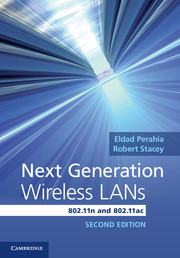Book contents
- Frontmatter
- Contents
- Foreword
- Preface to the first edition
- Preface to the second edition
- List of abbreviations
- Chapter 1 Introduction
- Part I Physical layer
- Part II Medium access control layer
- Part III Transmit beamforming, multi-user MIMO, and fast link adaptation
- Chapter 13 Transmit beamforming
- Chapter 14 Multi-user MIMO
- Chapter 15 Fast link adaptation
- Index
- References
Chapter 13 - Transmit beamforming
from Part III - Transmit beamforming, multi-user MIMO, and fast link adaptation
Published online by Cambridge University Press: 05 June 2013
- Frontmatter
- Contents
- Foreword
- Preface to the first edition
- Preface to the second edition
- List of abbreviations
- Chapter 1 Introduction
- Part I Physical layer
- Part II Medium access control layer
- Part III Transmit beamforming, multi-user MIMO, and fast link adaptation
- Chapter 13 Transmit beamforming
- Chapter 14 Multi-user MIMO
- Chapter 15 Fast link adaptation
- Index
- References
Summary
Adaptive transmit beamforming was introduced with the 802.11n standard amendment. With the 802.11ac standard amendment, transmit beamforming is greatly simplified using the experience gained from industry attempts to implement the various 802.11n transmit beamforming options.
With transmit beamforming (TxBF), we apply weights to the transmitted signal to improve reception. The weights are adapted from knowledge of the propagation environment or channel state information (CSI). Since by definition transmit beamforming weights are derived from channel information, spatial expansion as defined in Section 6.2 is not considered transmit beamforming.
The key advantage with transmit beamforming is the ability to significantly improve link performance to a low cost, low complexity device. This advantage is illustrated in Figure 13.1, which depicts a beamforming device with four antennas. Such a device could be an AP or a home media gateway. The device at the other end of the link has only two antennas, typical of a small client device. Such a system would benefit from 4 × 2 transmit beamforming gain from device A to device B. However, when transmitting from device B to device A, the system gain would be matched with 2 × 4 SDM with MRC as described in Section 6.1. Therefore link performance would be balanced in both directions.
- Type
- Chapter
- Information
- Next Generation Wireless LANs802.11n and 802.11ac, pp. 365 - 423Publisher: Cambridge University PressPrint publication year: 2013



